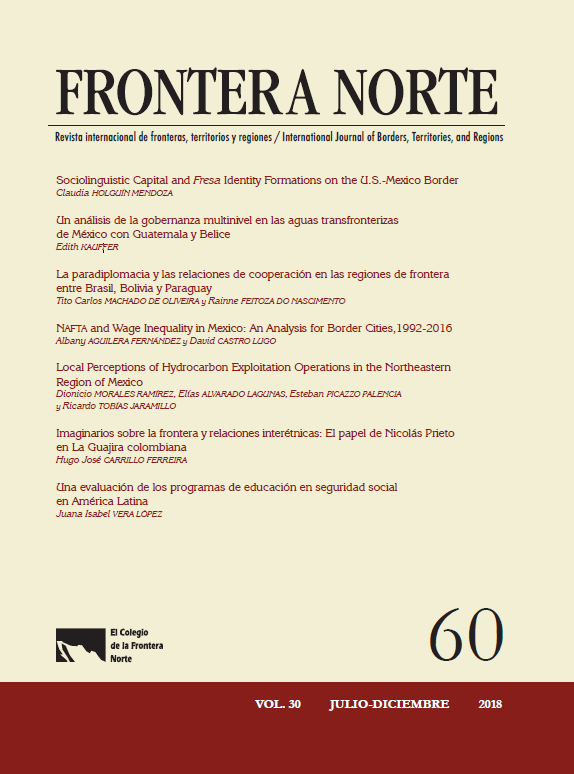Percepciones locales sobre las actividades de explotación de hidrocarburos en la región noreste de México
Contenido principal del artículo
Resumen
Detalles del artículo

Esta obra está bajo una licencia internacional Creative Commons Atribución-NoComercial-SinDerivadas 4.0.
Las/los autoras/es que publiquen en esta revista aceptan las siguientes condiciones:
- Las/los autoras/es conservan los derechos de autor y ceden a la revista Frontera Norte (RFN) el derecho de la primera publicación, mediante el registro de los textos con la licencia de Creative Commons Atribución-No comercial-Sin derivar 4.0 internacional (CC BY-NC-ND 4.0), que permite a terceros utilizar lo publicado siempre que mencionen la autoría del trabajo y a la primera publicación en esta revista.
- Autorizan que su artículo y todos los materiales incluidos en él sean reproducidos, publicados, traducidos, comunicados y transmitidos públicamente en cualquier forma o medio; así como efectuar su distribución al público en el número de ejemplares que se requieran y su comunicación pública, en cada una de sus modalidades, incluida su puesta a disposición del público a través de medios electrónicos o de cualquier otra tecnología, para fines exclusivamente científicos, culturales, de difusión y sin fines comerciales.
- Los autores/as pueden realizar otros acuerdos contractuales independientes y adicionales para la distribución no exclusiva de la versión del artículo publicado en esta revista (por ejemplo: incluirlo en un repositorio institucional, página web personal; o bien publicarlo en un libro) siempre que sea sin fines comerciales e indiquen claramente que el trabajo se publicó por primera vez en Frontera Norte (RFN), [agregando la ficha bibliográfica correspondiente: Autor/es. (año). Título del artículo. Frontera Norte, volumen (número), pp. doi: xxxx ].
Para ello, los autores deben remitir el formato de carta-cesión de la propiedad de los derechos de la primera publicación debidamente llenado y firmado. Este documento debe cargarse en formato PDF en archivos complementarios dentro de la plataforma OJS.

Este obra está bajo una licencia de Creative Commons Atribución-No comercial-Sin derivar 4.0 internacional (CC BY-NC-ND 4.0).
Citas
Boudet, H., Clarke, C., Bugden, D., Maibach, E., Roser-Renouf, C., & Leiserowitz, A. (2014). “Fracking” controversy and communication: Using national survey data to understand public perceptions of hydraulic fracturing. Energy Policy, 65, 57-67. doi:10.1016/j.enpol.2013.10.017
Brown, R. B., Dorius, S. F., & Krannich, R. S. (2005). The Boom-Bust-Recovery cycle: Dynamics of Change in Community Satisfaction and Social Integration in Delta, Utah. Rural Sociology, 70(1), 28-49.
Centro de Investigaciones Sociales de la Universidad Autónoma de Tamaulipas. (2015). Reporte de diagnóstico general social (p. 141). México: Centro de Investigaciones Sociales de la Universidad Autónoma de Tamaulipas. Retrieved January 31, 2018, from http://www.impactosshalenoreste.uat.edu.mx/Docu-
ments/II.%20DIAGNÓSTICO-GENERAL-SOCIAL.pdf
Comisión Nacional de Hidrocarburos (CNH). (2015). Seguimiento a la exploración de aceite y gas de Lutitas. Mexico City: CNH. Retrieved July 19, 2017, from
Choma, B., Hanoch, Y., & Currie, S. (2016). Attitudes toward hydraulic fracturing: The opposing forces of political conservatism and basic knowledge about fracking. Global Environmental Change, 38, 108-117.
Davidson, D. (1979). Overview of the boomtown phenomenon and its effect on women and minorities. In U.S. Commission on Civil Rights, Energy Resource Development: Implications for Women and Minorities in the Intermountain West (pp. 15-25). Washington, D. C.: U.S. Government Printing Office.
Energy Information Administration (EIA). (2013). EIA/ARI World Shale Gas and Shale Oil Resource Assessment. Arlington, VA: EIA. Retrieved July 19, 2017, from https://www.adv-res.com/pdf/A_EIA_ARI_2013%20World%20Shale%20Gas%20and%20Shale%20Oil%20Resource%20Assessment.pdf
Instituto Nacional de Estadística y Geografía (Inegi). (2015). Censo de Población y Vivienda 2010. Mexico City: Inegi. Retrieved September 11, 2015, from http://www.inegi.org.mx/est/contenidos/proyectos/ccpv/cpv2010/default.aspx
International Energy Agency (IEA). (2014). Reporte de estadísticas. Retrieved May 11, 2015, from http://www.iea.org/stats/
Jacobsen, G., & Parker, D. (2014). The Economic Aftermath of Resource Booms: Evidence from Boomtowns in the American West. The Economic Journal,126(593), 1092-1128. doi: 10.1111/ecoj.12173
Jacquet, J. (2009). Energy Boomtowns and Natural Gas: Implications for Marcellus Shale Local Governments and Rural Communities (Working Paper No. 43). University Park, PA: Northeast Regional Center for Rural Development, Pennsylvania State University. Retrieved May 1, 2015, from http://aese.psu.edu/nercrd/publications/rdp/rdp43
Jacquet, J. (2012). Landowner Attitudes toward Natural Gas and Wind Farm Development in Northern Pennsylvania. Energy Policy, 50, 677-688.
Kohrs, E. V. (1974). Social Consequences of Boom Growth in Wyoming. Paper presented at the Rocky Mountain American Association of the Advancement of Science Meeting in Laramie, Wyoming. Pindedale, WY: Sublette County. Retrieved from http://www.sublettewyo.com/ArchiveCenter/ViewFile/Item/97
Morales, D., & Roux, R. (2015). Estudio de impacto social: Antecedentes y líneas base para San Fernando, Tamaulipas. Revista Internacional de Ciencias Sociales y Humanidades, 25(1), 111-130. Retrieved August 9, 2017, from http://revistasociotam.campuscemir.mx/ojssociotam/index.php/SOCIOTAM/article/view/424/405
Petróleos Mexicanos (Pemex). (2016). Base de datos institucional de Pemex: Pemex-exploración y producción. Producción de gas natural por región y activo. Mexico City: Pemex. Retrieved December 21, 2016, from http://ebdi.pemex.com/bdi/bdi-Controller.do?action=cuadro&subAction=applyOptions
Secretaría de Energía (Sener). (2014). Prospectiva del gas natural y gas LP 2014-2028. Mexico City: Sener. Retrieved May 16, 2016, from https://www.gob.mx/
cms/uploads/attachment/file/352/Prospectiva-GasNaturalGasLP-2014.pdf
Secretaría de Desarrollo Social (Sedesol). (2013). Microrregiones: Cédulas de información municipal. Mexico City: Sedesol. Retrieved May 18, 2015, from http://www.microrregiones.gob.mx/zap/default.aspx?entra=nación
Schafft, K. A., Borlu, Y., & Glenna, L. (2013). The Relationship between Marcellus Shale Gas Development in Pennsylvania and Local Perceptions of Risk and Opportunity. Rural Sociology, 78(1), 143-166.
Statistical package for the social sciences (SPSS) 19. New York, NY: IBM.
Theodori, G. (2012). Public Perception of the Natural Gas Industry: Data from the Barnett Shale. Energy Sources, Part B, 7(3), 275-281.
Theodori, G., & Jackson-Smith, D. (2010). Public Perception of the Oil and Gas Industry: The Good, the Bad, and the Ugly. Society of Petroleum Engineers. Retrieved May 18, 2015, from http://www.shsu.edu/glt002/documents/spe134253-TheodoriandJackson-Smith.pdf
Whitmarsh, L., Nash, N., Upham, P., Lloyd, A., Verdon, J., & Kendall, M. (2015). UK public perceptions of shale gas hydraulic fracturing: The role of audience, message and contextual factors on risk perceptions and policy support. Applied Energy, 160, 419-430.
Williams, L., Macnaghten, P., Davies, R., & Curtis, S. (2017). Framing ‘fracking’: Exploring public perceptions of hydraulic fracturing in the United Kingdom. Public Understanding of Science, 26(1), 89-104. doi:10.1177/0963662515595159
